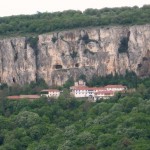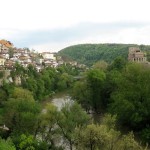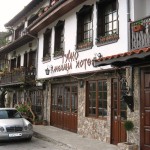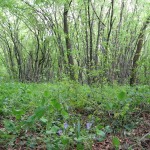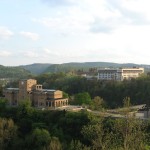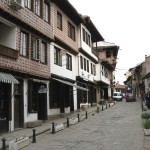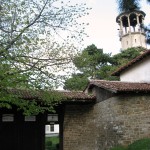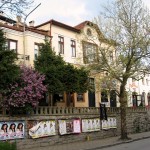The town of Veliko Turnovo (66 998 inhabitants, 210 metres above sea level) is regally situated along the historical hills of Sveta Gora, Tsarevets and Trapezitsa, on the two banks of the Yantra River, cutting a peculiar gorge through Turnovo Hills.
It is situated 240 km north-east of Sofia, 86 km east of Lovech, 46 km north-east of Gabrovo, 50 km east of Sevlievo, 43 km south-east of Pavlikeni, 42 km north-east of Tryavna, 106 km south-west of Rousse, 7 km south-west of Gorna Oryahovitsa and 100 km south-west of Targovishte.
History: Veliko Turnovo is the town with the most glorious historical past in Bulgaria. It is a symbol of Bulgarian statehood and a source of national pride for every Bulgarian. Each little place in it is history.
The earliest traces were found on the Trapezitsa Hill (dating back to first half of the 3rd millennium BC). Remnants on Tsarevets Hill date back to the end of the Bronze Era (13th century BC). This oldest settlement was inhabited by Thracians (the tribes of uzdicenses and crobises) and existed by the end of the Iron Era. Its prosperity is related to 6th century BC – till 1st century AC. Its traces in the first centuries of the Roman Rule are lost on our lands (at the beginning of the new era).
The next layer of Tsarevets is early Byzantine, from the 5th to the first half of the 7th century when there was a fortified town on the hill (one of the supporting points of Byzantium in the northern part of the Balkan Peninsula), which withstood for 3 centuries. A big Slavonic-Bulgarian settlement of the 8th to 10th century was founded on the ruins of this town. At the end of the 10th century the hill was already densely populated and in the 12th century it was a fortified town and a significant economic centre.
The origin of the name is related to the Slavonic word “tern†or “trun†(thorn) and during the years it developed into Ternov, Trunov, Tur-nov, Turnovgrad, Turnovo and Veliko Turnovo, being called “Veliko†(Great) in relation to its size, beauty and grandeur. In 1187 the Uprising of Assen and Peter was successfully completed, the Byzantine Rule was thrown off and Tur-novgrad became the capital (the third capital in the history of Bulgaria) of the restored Bulgarian Kingdom. The following two centuries are “golden†in the history of the town.
The Tsar’s Palace and the Bulgarian Patriarchy were situated on the Tsarevets Hill and the houses of the bolyars and the senior priesthood as well as a lot of churches were situated on Trapezitsa Hill.
Assenova Mahala (quarter), located between the above mentioned hills, by the Yantra River, was inhabited by craftsmen. The district of foreign merchants (Franks) was to the south-east of the Baldwin Tower. Thick fortified walls of the “internal town†protected Tsarevets and Trapezitsa. The other two quarter also had fortified protection and formed the “external townâ€. Solely the dwellings of the destitute among the non-privileged people remained outside the fortifications at the foothill of the Momina Krepost (Maiden’s Fortress) Hill, in the immediate proximity of the Yantra River. During the 13th and 14th centuries the capital of Bulgaria was a big political, economic, trade and cultural centre in Europe. The Bulgarian State reached the heights of its development during this period. Along with Byzantium it was the first power on the Old Continent.
Magnificent palaces, monasteries, churches, fortifications, bridges, big houses were built here. The Turnovo School of Painting and the Turnovo Literary School, whose founders, organisers and most prominent representatives are Patriarch Evtimii and Teodosii Turnovski (of Turnovo), developed and carried out their versatile activities here. All the prosperity and spiritual upsurge was discontinued on 17th July 1393, when after a 3-month siege Veliko Turnovo, and gradually the whole of Bulgaria succumbed under Ottoman Rule… The Metropolitan town was in ashes.
Centuries were to pass before the town was able to recuperate and experience a new economic, cultural and political upsurge during the Revival period. Crafts developed, trade flourished, beautiful houses, public buildings, churches (with the greatest contribution in that respect belonging to the unsurpassed Master Kolyu Ficheto), the aspiration for enlightenment and national self-awareness started to find their implementation and the struggle for ecclesiastical and national independence gained strength.
The population of the old Bulgarian Metropolis took part in the Turnovo Uprisings of 1598, 1686 and 1700, in Velcho Conspiracy (1835), in the Uprising of Captain Dyado Nikola (1856), in Hadzhi Stavrev’ Revolt (1862) and in the April Uprising of the rebellious year of 1876. Then Bacho Kiro, Tsanko Dyustabanov and a lot of other fighters for freedom were hanged under the gallows erected in the town square. The Apostle Levski came here more than once (the last time in 1872, unfortunately enchained).
On 7th July 1877 Veliko Turnovo was free again. From 10th February to 16th April 1879 the Constituent Assembly, which developed the First Bulgarian Constitution – the Turnovo Constitution, one of the most democratic constitutions in Europe for that time, convened here. On 17th April 1879 the first Great National Assembly of liberated Bulgaria convened in Veliko Turnovo to elect a head of state. On 27th July the same year Alexander Battenberg was elected as Bulgaria’s knyaz (first prince). It was namely here that on 6th September 1885 Stefan Stambolov and Petko Karavelov made the decision to acknowledge the union of the Principality of Bulgaria with Eastern Roumelia.
Although Sofia became the capital of Bulgaria after the Liberation, Veliko Turnovo continued to be a sanctuary for all Bulgarians, a bastion of Bulgarian national spirit and self-awareness. It is the birthplace of Petko R. Slaveikov, of the great actor Konstantin Kissimov, of the writers Emiliyan Stanev and Dimitur Mantov and of a lot of other eminent Bulgarians.
Landmarks:
The Tsarevets Hill Archaeological Reserve
The second largest architectural complex of Tsarevets is Bulgarian Patriarchy. The Patriarchal complex rose at the highest place, above the Tsar’s Palace. It occupied an area of about 3000 square metres, shaped as an individual fortress in the shape of an irregular polygon. The Lord’s Ascension Patriarchal Church with a belfry tower – a phenomenon scarcely met in the ecclesiastical architecture on the Balkans rose in the centre of the yard. The excavated foundations of residential buildings and churches along the steep slope of Tsarevets, east and south of the Patriarchy, forming a little quarter of the Medieval town are of a special interest. A big bolyar settlement north of Tsarevets was studied, too which with its architectural pattern is the prototype of Bulgarian Revival house. One of the most valuable Medieval Bulgarian monuments – Forty Holy Martyrs Church is situated at the western foothill of Tsarevets Hill, near the river. It was erected by order of Tsar Ivan Assen II in honour of his great victory over the Byzantines at Klokotnitsa on 22nd March 1230. During the 18th century the Turks turned it into a mosque but a part of the valuables contained in it are still preserved. Thus, for instance, the three preserved stone columns – Assen’s, Omourtag’s and the one from the Rodosto Fortress are of an exceptional importance to historical science and prove the succession in the Bulgarian statehood.
Tsar Kaloyan’s grave and his golden 61-gram ring-seal were found during excavation works in the 1970-ies. The St. St. Peter and Pavel Church rises at the foothill of the northern slope of Tsarevets – the only better preserved church from Medieval Turnovgrad. After the town succumbed to Ottoman Rule the Bulgarian Patriarchy and the whole Patriarchal library was moved to it. The last Bulgarian Patriarch – Evtimii served in this church for about two years before being sent in exile.
Tsarevets Hill finishes in its north-eastern end with a strongly protruding over the Yantra River Lobna Skala (Rock at the place of death) from which traitors were thrown down.
The Trapezitsa Hill is related to the earliest manifestations of the Bulgarian rulers in the 12th century. In 1185 the St. Dimitur Solunski Church was built in the outskirts of the hill and during its consecration the brothers Assen and Peter proclaimed the Uprising against the Byzantine invaders. It was a royal church up to the year 1230 and Assen, Peter and Kaloyan were crowned in it. Here on 7th November 1204 Archbishop Vassilii was promoted to the rank of Patriarch of Bulgarian church. The church was shown mercy after Turnovo fell under Ottoman Rule. A lot of fighters for spiritual and national liberation were buried in its courtyard during the 19th century. The church was almost completely destroyed during the second half of the 19th century. The St. Georgi Church is also situated in the eastern outskirts of the hill. It was erected in 1612 in the place of a destroyed Medieval Bulgarian church. The most interesting things in it are the mural paintings whose unknown author had shown himself as a follower of the best traditions of Turnovo School of Painting. A lot of dwellings of boyars were found during excavation works and there was a little family church in nearly each of them.
In 1195 by an order of Tsar Ivan Assen I, the relics of St. Ivan Rilski were rested in a monastery located on the hill. The relics of the St. Gavrail Lesnovski were moved by Tsar Kaloyan to the Holy Apostles Church located on the same hill.
The quarter on the two sides of the river between Tsarevets and TrapezitsaHills where the 4 valuable historical churches are located (St. Dimitur Solunski, St. Georgi, Forty Holy Martyrs and St. St. Peter and Pavel) is called Ðssenova Mahala (Assen’s quarter) and constituted the fundamental part of the so-called “external townâ€. It originated during the reign of Tsar Ivan Assen II (1218-1241).
Sveta Gora is the third hill of the Metropolis Turnovgrad. It rises south of Tsarevets and it was a cultural and spiritual centre of the Bulgarian State in Medieval times. There were a lot of churches and monasteries here. The Turnovo Literary School and the Turnovo School of Painting developed a versatile and vivacious activity in the biggest of the monasteries – Holy Virgin Odigitriya. Here the Titans of the Medieval Bulgarian spirit – Patriarch Evtimii and Teodosii Turnovski did creative works here. Today the buildings of St. St. Cyril and Methodius Veliko Turnovo University rise on the place of the monastery.
After Veliko Turnovo fell under Ottoman Rule the town started to expand to the west little by little. Predominantly Turks settled down along the hills of Tsarevets and Trapezitsa and predominantly Bulgarians settled down in the new quarters. Construction of a lot of new private and public buildings commenced with the growing economic prosperity of the Bulgarians during the Revival period, a great part of which still adorn the Old town (between the hills of Trapezitsa and Sveta Gora, separated from them through the meanders of the Yantra River).
The self-educated Bulgarian architect and builder Master Kolyo Ficheto greatly contributed in this respect. He created several of them – the Konak (police station) (1872), related to a lot of historical events (to the interrogation of the captured Levski in 1872, to the Turkish court trial of the revolutionaries Bacho Kiro, Tsanko Dyustabanov, Georgi Izmirliev, Ivan Semerdzhiev, Ekim Tsankov and others in 1876, to the welcoming of the Russian liberators in 1877, to the Constituent Assembly in 1879 and the First Great National Assembly convened during the same year, to the decision for the acknowledgement of the Union in 1885). The Inn of Hadzhi Nikola (1858), one of the most interesting architectural monuments of the Revival period. The St. St. Cyril and Methodius Church (1861), St. Spas (Ascension) Church (1862-1863) and St. Konstantin and St. Elena Church (1872), as well as the House with the Monkey (1849, in the centre of the town), taking its name form the sitting monkey placed above the ground floor with an inscribed sign plate under it. The Museum of the Second Bulgarian State is located near the Konak. The home of Petko R. Slaveikov. The St. Nikola Church (1836) during whose construction Kolyu Ficheto worked as an apprentice. The prison-museum (1862) where a lot of freedom-loving Bulgarians were sent, among them Levski, Philip Totyu, Stefan Karadzha, Bacho Kiro. The house of Kokona (Grand Lady) Anastassia (of the end of the 18th century. Stambolov’s Inn (was owned by Stefan Stambolov’s family, the rebellious Captain Dyado Nikola worked here, too). The monument to Velcho Conspiracy in the square of the same name. Gourko Street with a lot of Revival Period houses in it adds romantic atmosphere to the Old Town. Built steeply above the river, it seems as if they have perched one over the other. One of the most beautiful buildings in this street is Sarafkin’s House (Money-changer’s) (1861).
The Art Gallery (tel.: 062 38951) and the monuments to the Assens’ Dynasty in front of it are located on a picturesque peninsula (Borouna), rising above the Yantra River. There are a lot of other interesting old houses, public buildings, squares, dozens of monuments, too. It is difficult to describe Veliko Turnovo, it is worth seeing with one’s own eyes!
Accommodation:
- The Veliko Turnovo Interhotel (2, Alexander Penchev Street).
- The Yantra Hotel (3-star, 2, Opulchenska Street).
- The Sveta Gora Motel (in the south-eastern end of the Sveta Gora Park).
- Orbita Hotel (downtown, offers 50 beds, ‘tourist’ category).
- Trapezitsa Tourist House (in the centre of the town, 79, Stambolov Street, it has 73 beds in 2 suites and in 2-, 3- and 4-bed rooms.
- Momina Krepost Tourist House (Maiden’s Fortress) (in the Ksilofor Area, east of town, near the last stop of town bus lines No. 7 and No. 11 and 2-km further walk, it offers 178 beds in 3 suites and in 2-, 4- and 5-bed rooms).
There are cosy and typical Bulgarain public catering and entertainment establishments offering traditional Bulgarian cuisine in Veliko Turnovo. One of them is the tavern in the House with the Monkey, working hours: 11.00 a.m. – 12.00 p.m., 14, Vustannicheska Street).
Tourist information:
- at the Tourist InformationCentre – 5000 Veliko Turnovo (13A, Hristo Botev Str., tel.: 062(P. O. Box 5000, at the Veliko Turnovo Hotel, tel.: 062 22148, e-mail: dtour@vali.bg),
- at the Council on Tourism, 5000 Veliko Turnovo (at Veliko Turnovo Hotel, tel.: 062 30571, 30353, 528057);
- at Trapezitsa Tourist Association (79, Stefan Stambolov Street, tel.: 062 21593, 35185);
- at the hotels and in the tourist houses.
Transport: The town of the old Metropolis is connected with bus and a railway transport. There are regular bus lines to Sofia, Gabrovo, Rousse, Lovech, Kazanlak, Tryavna, Drya-novo, Sevlievo, Gorna Oryahovitsa (a town bus line), Lyaskovets (a town bus line), Pavlikeni, Turgovishte, Popovo, Byala and other smaller settlements within the region.
The bus station (86, Nikola Gabrovski Street, tel.: 062 40908) and the central railway station (tel.: 062 620065) are far from each other, the first being located in the western end of the town, and the second – in the southern end of the town immediately under the Sveta Gora Hill.
There is another railway station – Trapezitsa, north-west under the hill of the same name. Both stations are at they main railway line Rousse – Gorna Oryahovitsa – Stara Zagora – Podkova. Moreover, the railway station of Gorna Oryahovitsa (the biggest railway junction of Northern Bulgaria) is located at the distance of only several kilometres north-east of Veliko Turnovo.
At the railway station there is a taxi service for Veliko Turnovo passing through the village of Arbanassi. The following travel agencies are located there, too:
- Group (for bus tickets in the country and abroad, 1, Al. Stam-boliiski Street, tel.: 062 628292),
- Rila Railway Bureau (13A, Hr. Botev Street, tel.: 062 22130),
- Rila International Travel Bureau (13A, Hr. Botev Street, tel.: 062 22042),
- Inter-tour (an agent of Balkan Airlines, 13A, Hr. Botev Street, tel.: 062 21545)
- and Sema Express (airlines ticket bureau, 25, Nikola Gabrovski Blvd., tel.: 062 621586).
The town has a regular town bus and trolley-bus transport.


















